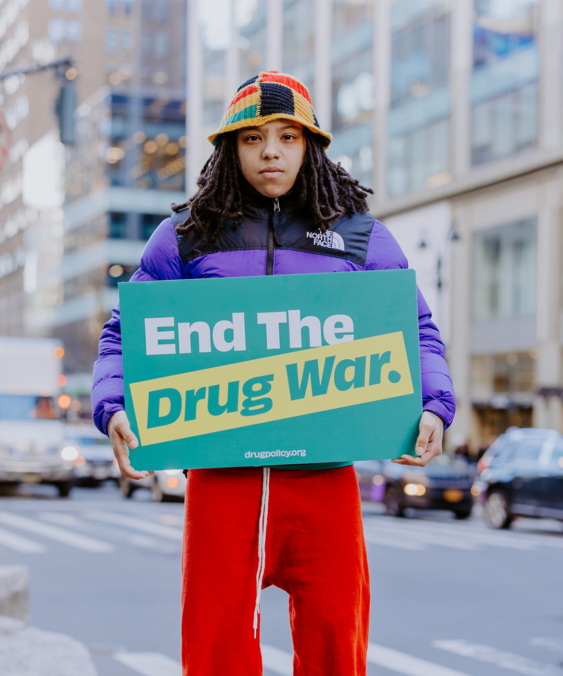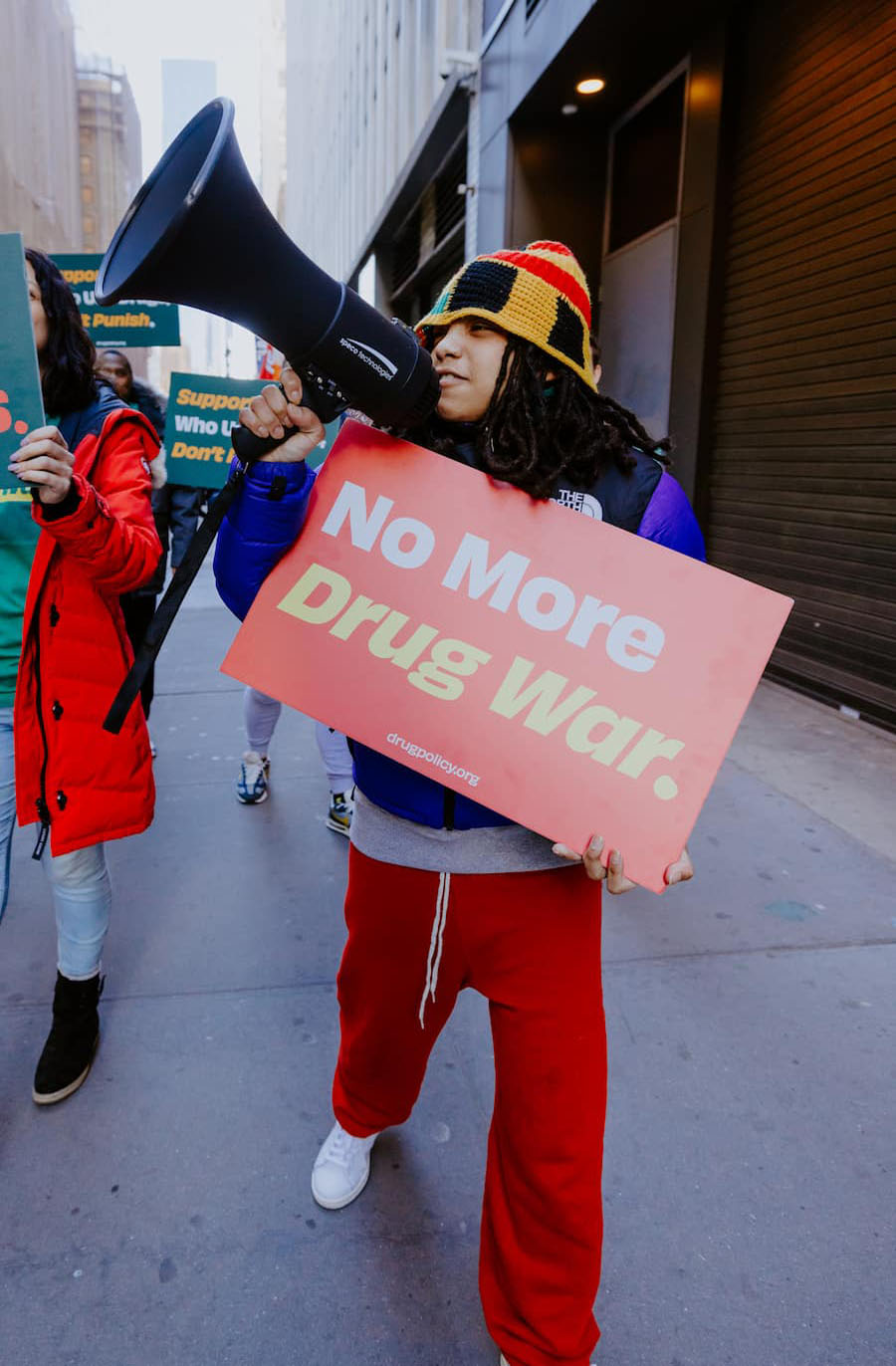
Tony Newman at 646-523-6961 or Shayna Samuels at 718-541-4785
(Meadowlands, NJ – Nov. 6) — Hundreds of people from around the country gathered today in New Jersey to oppose the war on drugs and promote more humane, cost-saving alternatives. The gathering — Reason * Compassion * Justice: The Drug Policy Alliance 2003 Biennial Conference – attracted elected officials, health care and drug treatment professionals, activists and family and friends of drug war prisoners. Topics included treatment instead of jail for drug offenders, medical marijuana for patients suffering from AIDS, cancer and other serious illnesses and clean syringe access for injection drug users to help prevent the spread of infectious disease to their loved ones and each other.
“Just about everyone in New Jersey has paid a steep price for the war on drugs – from prisoners and their families to cops and judges, from people struggling with addiction to taxpayers and policymakers,” said Ethan Nadelmann, executive director of the Drug Policy Alliance. “Few states have suffered so much, and few could gain so much from basic reforms.”
Kicking off the conference was the release of a groundbreaking new report — Costs and Benefits? The Impact of Drug Incarceration in New Jersey. The report, commissioned by the Drug Policy Alliance and conducted by the Justice Policy Institute, is the first in-depth look at how New Jersey’s drug policies are wreaking havoc on taxpayers, communities of color, and the state’s economic and social fabric. For a copy of the report please go to http://www.drugpolicy.org/docUploads/archive/jpi_njreport.pdf
“New Jersey wastes valuable human and financial resources by incarcerating drug offenders who don’t need to be behind bars,” said Vincent Schiraldi, executive director of the Justice Policy Institute. “States like Texas and Michigan are reforming their drug laws to divert drug offenders into treatment instead of prison. New Jersey needs to move towards the more effective and less expensive solution of treatment for drug offenders.”
Following are the 10 major findings from the Justice Policy Institute’s new report:
1) New Jersey has the highest known proportion of prisoners incarcerated for drug offenses in the country; and the highest drug prison admission rate in the country. According to the New Jersey Department of Corrections, 36% of New Jersey’s inmate population consists of drug offenders-the highest in the country, and 80% higher than the national average. According to the latest available data (1999) of the states reporting, New Jersey also led the nation in having the largest proportion of its prison admissions (48%) comprised of drug offenders. By contrast, drug offenders represented 27% of prison admissions nationally in 1999, putting New Jersey at 77% above the national average.
2) The increasing imprisonment of drug offenders in New Jersey has had a more concentrated affect on communities of color, particularly African Americans. In New Jersey, African Americans and Latinos represent 27% of the state’s general population, but eight out of ten prisoners in New Jersey are people of color. According to the latest figures, 63% of state prisoners are African American and 18% are Hispanic. The proportion of White prisoners in New Jersey actually declined from 31% in 1982 to 18% by 2001.
3) New Jersey’s sentencing structure, including laws that mandate imprisonment for drug offenses, have contributed significantly to the state’s high proportion of drug offenders and its racially disparate use of incarceration. The state’s Department of Corrections reports that “inmates with mandatory minimum terms serve approximately twice as much time as inmates without mandatory minimums.” The Department of Corrections also reported that “Drug-free school zone laws impact the minority population greatly as such ‘zones’ cover most inner-city neighborhoods but little of suburbia.”
4) The financial impact of maintaining New Jersey’s prison population is large, both in direct costs, and costs to communities and the state’s economic and social fabric. JPI estimates that the state spends $266 million a year in direct costs to maintain its drug prisoner population, an amount greater than what a third of the states spend on their entire corrections system. The $825 million increase in corrections spending over the 1980s and 1990s is equal to more than 20% of the budget shortfall that the state was grappling with earlier this year-when cuts were made to education, health care and social services. While prisons are not wholly responsible for the state’s fiscal woes, the increase in prison spending represents large new annual costs that force the state to choose between classrooms and cellblocks.
5) While New Jersey has expanded drug treatment options, treatment needs are outstripping demand in and out of prison. In 2001, there were 1,359 therapeutic community beds in six different prisons, up from 329 as recently as 1998. Still, the state had 7,300 drug prison admissions in 1999, and the DOC reports that there are 200 to 500 prisoners on waiting lists for drug treatment slots at any point in time. New Jersey treatment providers note that there is no consistent continuum of care for those transitioning from prison back to the community, which places returning addicts at high risk. The Department of Corrections has recommended strengthening its continuum of care, including more treatment for people leaving prison to their communities.
6) Parole Violators Comprise a Significant Proportion of Prison Admissions in New Jersey. Approximately 14,000 people are admitted to prison in New Jersey each year. Of those, one-third (4,600) are technical parole violators. While it is not clear what proportion of the state’s technical parole violators are being sent back for simple drug use, it is clear that the Department of Corrections is concerned about the problem, as they reported recently: “There is a need for the establishment of a current, clearly defined review criteria in order to avoid the re-incarceration of marginal parole violators.”
7) States like New Jersey that increased their use of prison for drug offenses at higher rates than other states did not experience less drug use than states that made more moderate use of prison for drug offenders. The Justice Policy Institute compared drug use with the drug prison admissions in New Jersey and 21 other states to evaluate whether more incarceration for drug offenses correlates with less drug use, as policymakers surely hope. JPI researchers tested whether states with high rates of incarceration for drug offenses experienced a statistically significant decrease in drug use and found there is no statistically significant basis for believing that increasing prison admissions for drug offenses deters drug use.
8) While the number of women imprisoned in New Jersey is small, their numbers are increasing at a higher rate than men, and the impact of their incarceration on their families and communities is huge. Between 1990 and 2002, the number of women incarcerated in the state’s corrections system grew at a rate 67% greater than the increase for men (52% vs. 31%). A higher proportion of women incarcerated in prison in New Jersey are there for drug offenses than men. While the economic impact of women’s crimes are small, the economic impact of the prison term typically meted out to a woman is huge. Women are far more likely than men to have been living with dependent children when they were arrested, and most women prisoners’ children are displaced-living with extended family members or friends–while they are incarcerated.
9) New Jersey’s drug offenders will face barriers getting jobs upon release from prison. Princeton University’s Bruce Western and Katherine Beckett found that youth who spent some time incarcerated experienced three weeks less work a year as compared to youth who had no history of incarceration. In addition, there are 22 categories of jobs for which certain criminal convictions serve as an absolute bar to employment, including: bartenders and waiters in establishments where liquor is served, New Jersey Turnpike Authority employees and retail, and wholesale, manufacturing or distributing employees.
10) Nearly 1 out of 10 African American voting age residents in New Jersey cannot vote because of their involvement in the criminal justice system. Felony disenfranchisement, where people under criminal justice control for a felony offense (or people who once were convicted of a felony offense and have completed their sentence) lose their right to vote, is emblematic of the various collateral consequences that impact ex-prisoners. Researchers have shown that in New Jersey, of 6.24 million voting age residents in 2000, 143,000 people (or 2.3% of the electorate) cannot vote due to felony disenfranchisement. Seventy-eight thousand of these were African Americans, representing 9.2% of all African American voting age residents.
ATTENTION JOURNALISTS: For a complete copy of Costs and Benefits? The Impact of Drug Incarceration in New Jersey — embargoed until 12:01 AM on Thursday, Nov. 6 — or to obtain a press pass for the Drug Policy Alliance’s biennial conference, please contact Tony Newman at 646-523-6961. Costs and Benefits was funded by generous grants from the Butler Family Fund and the Tides Foundation.

Election Day is around the corner… and we must be prepared to shape the national conversation about drugs. We need 250 donors to come forward before July 31!
